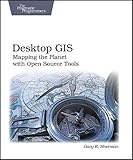 Desktop GIS: Mapping the Planet with Open Source by Gary Sherman
Desktop GIS: Mapping the Planet with Open Source by Gary ShermanMy review
rating: 4 of 5 starsDesktop GIS covers Open Source software for use as a Geographic Information Systems (GIS). In particular, it covers the following programs and libraries:
- Quantum GIS
- uDig
- GRASS(and its Java front end JGrass http://www.jgrass.org)
- PROJ.4
- GDAL/OGR
- PostGIS
- FWTools
- GMT
At the beginning of the book, the author outlines three classes of users. A casual user who only needs to look at data found from elsewhere, an intermediate user who visualizes but also creates or converts data, and an advanced user who has the need to do spatial analysis. To cover all of these is an ambitious goal, which is further diluted by the authors felt need to cover the entirety of open source mapping in one book.
What the author does well is to identify tools, and explains what can do what with enough to get you started. So Quantum GIS and uDig are the viewers, able to read almost any GIS format (in particular the readily-available ESRI Shapefiles as well as PostGIS). GDAL and OGR that can convert anything to anything (including delimited text. These are often distributed as FWTools). PROJ.4 that converts projections from one to another (and is embedded in everything). PostGIS which is the spatial database that enables spatial analysis. And GRASS, which is the full-fledged can-do-everything-but-is-hard-to-learn tool. And then some random programs that either do something completely different (e.g. OSSIM, which is an imagery analysis tool) or can make a picture of a map with lots of options (e.g. GMT).
What he provides are the basics for the casual or intermediate user. The advanced GIS analyst would only have a taste of what GRASS can do, but would not know what can be done with it. Similarly, while the intermediate user will get a sense of what PostGIS can do, the lack of space to cover spatial extensions to SQL supported by PostGIS loses its value to the advanced user. What could have made this book better was more focus. If the author was compelled to have a survey of all open source mapping, it may have gone into an appendix with a few paragraphs for each of the miscellaneous tools. But for the book, one good focus would have been the GIS stack comprising of data storage, data analysis and data viewing. Basically the open source counterpart to the ArcGIS/Oracle with Spatial Extensions. And everything that does not play a role in the stack, gets pushed into the appendix.
What could have been done? The book tended to be organized by tool. But once past the casual user, almost all tasks required multiple tools. I would have gone:
1. Viewing data (raster, vector, introduction to QGIS, uDig, GRASS)
2. Converting data/data formats (GDAL/OGR, Maybe PROJ.4)
3. Creating/Editing data (digitizing, importing)
4. Spatial databases (PostGIS)
5. Geoprocessing/spatial analysis - GRASS, PostGIS, R-spatstats
6. Tools integration (QGIS/uDig with GRASS/PostGIS)
7. Scripting
8. Customization
and everything that did not fall into this gets a page in an appendix.
Knowing where to start is a big help. Most of the websites either focus on one product, or try to teach everything as being equally important. Gary Sherman at least identifies the main building blocks. (QGIS or uDig, GDAL/OGR/PROJ.4, PostGIS, GRASS) and gives enough to get started. And this can be very helpful, so at least the starting analyst knows where to start.
What would be next? For the person still working within the GIS stack (as opposed to a completely different topic, like imagery analysis which is OSSIM's territory) there are a few obvious topics.
1. PostGIS - Spatial databases with SQL. Maybe even connections with ArcGIS. Even a short (10 pg) appendix would have done wonders here.
2. GRASS - The author devotes an additional appendix to this. But to do this right, you probably need to refer to Open Source GIS: A GRASS GIS Approach
3. R spatial statistics packages. Applied Spatial Data Analysis with R would cover this.
Mostly, a good book to get started in GIS using Open Source tools. Casual users would be well served. Intermediate users would get started and can find the rest using the internet. Advanced users are going to miss alot (to the point they don't even realize that these tools were a worthy alternative).
View all my reviews at Goodreads.
No comments:
Post a Comment